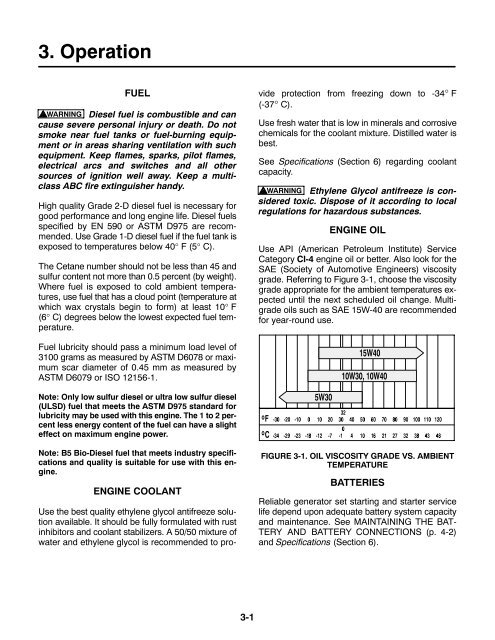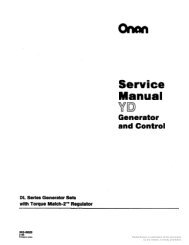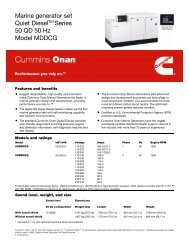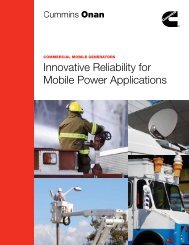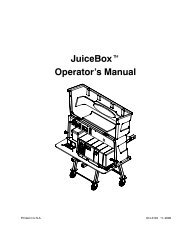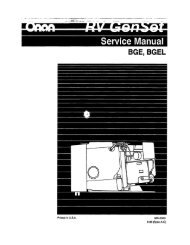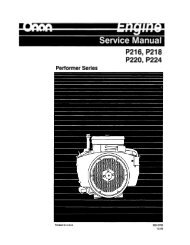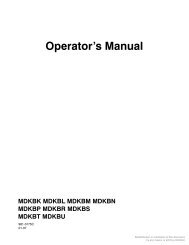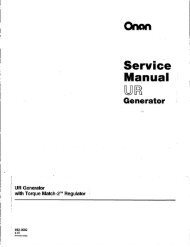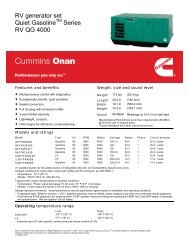Operator Manual - Cummins Onan
Operator Manual - Cummins Onan
Operator Manual - Cummins Onan
You also want an ePaper? Increase the reach of your titles
YUMPU automatically turns print PDFs into web optimized ePapers that Google loves.
3. Operation<br />
FUEL<br />
WARNING Diesel fuel is combustible and can<br />
cause severe personal injury or death. Do not<br />
smoke near fuel tanks or fuel-burning equipment<br />
or in areas sharing ventilation with such<br />
equipment. Keep flames, sparks, pilot flames,<br />
electrical arcs and switches and all other<br />
sources of ignition well away. Keep a multiclass<br />
ABC fire extinguisher handy.<br />
High quality Grade 2-D diesel fuel is necessary for<br />
good performance and long engine life. Diesel fuels<br />
specified by EN 590 or ASTM D975 are recommended.<br />
Use Grade 1-D diesel fuel if the fuel tank is<br />
exposed to temperatures below 40° F (5° C).<br />
The Cetane number should not be less than 45 and<br />
sulfur content not more than 0.5 percent (by weight).<br />
Where fuel is exposed to cold ambient temperatures,<br />
use fuel that has a cloud point (temperature at<br />
which wax crystals begin to form) at least 10° F<br />
(6° C) degrees below the lowest expected fuel temperature.<br />
Use the best quality ethylene glycol antifreeze solution<br />
available. It should be fully formulated with rust<br />
inhibitors and coolant stabilizers. A 50/50 mixture of<br />
water and ethylene glycol is recommended to provide<br />
protection from freezing down to -34° F<br />
(-37° C).<br />
Use fresh water that is low in minerals and corrosive<br />
chemicals for the coolant mixture. Distilled water is<br />
best.<br />
See Specifications (Section 6) regarding coolant<br />
capacity.<br />
WARNING Ethylene Glycol antifreeze is considered<br />
toxic. Dispose of it according to local<br />
regulations for hazardous substances.<br />
ENGINE OIL<br />
Use API (American Petroleum Institute) Service<br />
Category CI-4 engine oil or better. Also look for the<br />
SAE (Society of Automotive Engineers) viscosity<br />
grade. Referring to Figure 3-1, choose the viscosity<br />
grade appropriate for the ambient temperatures expected<br />
until the next scheduled oil change. Multigrade<br />
oils such as SAE 15W-40 are recommended<br />
for year-round use.<br />
Fuel lubricity should pass a minimum load level of<br />
3100 grams as measured by ASTM D6078 or maximum<br />
scar diameter of 0.45 mm as measured by<br />
ASTM D6079 or ISO 12156-1.<br />
Note: Only low sulfur diesel or ultra low sulfur diesel<br />
(ULSD) fuel that meets the ASTM D975 standard for<br />
lubricity may be used with this engine. The 1 to 2 percent<br />
less energy content of the fuel can have a slight<br />
effect on maximum engine power.<br />
Note: B5 Bio-Diesel fuel that meets industry specifications<br />
and quality is suitable for use with this engine.<br />
ENGINE COOLANT<br />
FIGURE 3-1. OIL VISCOSITY GRADE VS. AMBIENT<br />
TEMPERATURE<br />
BATTERIES<br />
Reliable generator set starting and starter service<br />
life depend upon adequate battery system capacity<br />
and maintenance. See MAINTAINING THE BAT-<br />
TERY AND BATTERY CONNECTIONS (p. 4-2)<br />
and Specifications (Section 6).<br />
3-1


